Half Adder Using Verilog
Last Updated :
16 Jul, 2023
A half adder is a digital logic circuit that performs binary addition of two single-bit binary numbers. It has two inputs, A and B, and two outputs, SUM and CARRY. In this article we will discuss how to implement a Half adder Using Verilog HDL.
Aim: Develop a Half Adder using Verilog module.
Theory: Half adder is also called as simple Binary Adder. It has two inputs A & B and outputs Sum & Carry.
- Sum is the XOR of inputs A&B
- Carry is the AND of inputs A&B
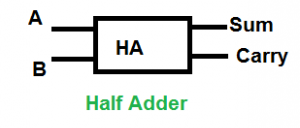 Truth Table
Truth Table
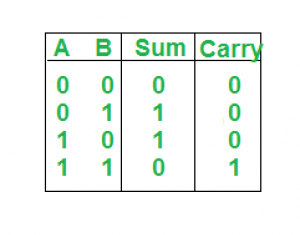
K-Map
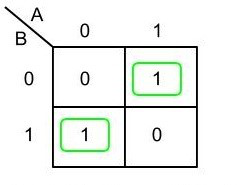
S= A B' + A' B
S= A XOR B
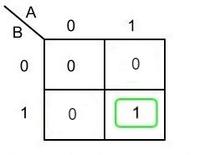
Carry= A.B
Implementation Using Logic Gates
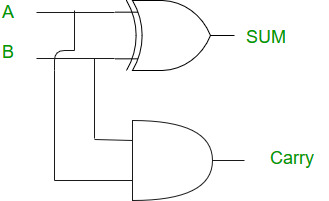
Verilog Code
Structural Method
module half_adder_structural (
input a, // Input 'a'
input b, // Input 'b'
output s, // Output 's' (Sum)
output c // Output 'c' (Carry)
);
xor gate_xor (s, a, b); // XOR gate for sum
and gate_and (c, a, b); // AND gate for carry
endmodule
Dataflow Representation
module half_adder_dataflow (
input a, // Input 'a'
input b, // Input 'b'
output s, // Output 's' (Sum)
output c // Output 'c' (Carry)
);
assign s = a ^ b; // Dataflow expression for sum
assign c = a & b; // Dataflow expression for carry
endmodule
Behavioral Representation
module half_adder_behavioral (
input a, // Input 'a'
input b, // Input 'b'
output s, // Output 's' (Sum)
output c // Output 'c' (Carry)
);
// Combinational logic equations for sum and carry
always @(*) begin
s = a ^ b; // XOR operation for sum
c = a & b; // AND operation for carry
end
endmodule
Test Bench
module half1_adder;
// Declare registers
reg d; // Register 'd' for input 'a'
reg e; // Register 'e' for input 'b'
// Declare wires
wire f; // Wire 'f' for output 's' (Sum)
wire g; // Wire 'g' for output 'c' (Carry)
// Instantiate half_adder module
half_adder half2_adder (.a(d), .b(e), .s(f), .c(g));
// Initial block for simulation
initial begin
$dumpvars(1, half1_adder); // Enable waveform dumping for simulation
// Test case 1
d = 1'b1; // Assign input 'a' as 1
$display("a=%b", d); // Display value of input 'a'
e = 1'b1; // Assign input 'b' as 1
$display("b=%b", e); // Display value of input 'b'
#10; // Wait for 10 time units
$display("s=%b", f); // Display value of output 's' (Sum)
$display("c=%b", g); // Display value of output 'c' (Carry)
// Test case 2
d = 1'b0; // Assign input 'a' as 0
$display("a=%b", d); // Display value of input 'a'
e = 1'b1; // Assign input 'b' as 1
$display("b=%b", e); // Display value of input 'b'
#10; // Wait for 10 time units
$display("s=%b", f); // Display value of output 's' (Sum)
$display("c=%b", g); // Display value of output 'c' (Carry)
// Test case 3
d = 1'b1; // Assign input 'a' as 1
$display("a=%b", d); // Display value of input 'a'
e = 1'b0; // Assign input 'b' as 0
$display("b=%b", e); // Display value of input 'b'
#10; // Wait for 10 time units
$display("s=%b", f); // Display value of output 's' (Sum)
$display("c=%b", g); // Display value of output 'c' (Carry)
// Test case 4
d = 1'b0; // Assign input 'a' as 0
$display("a=%b", d); // Display value of input 'a'
e = 1'b0; // Assign input 'b' as 0
$display("b=%b", e); // Display value of input 'b'
#10; // Wait for 10 time units
$display("s=%b", f); // Display value of output 's' (Sum)
$display("c=%b", g); // Display value of output 'c' (Carry)
end
endmodule
Share your thoughts in the comments
Please Login to comment...